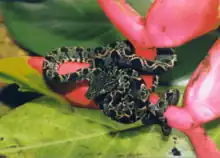| Corallus hortulana | |
|---|---|
 | |
| Juvenile in Ecuador | |
| Scientific classification | |
| Domain: | Eukaryota |
| Kingdom: | Animalia |
| Phylum: | Chordata |
| Class: | Reptilia |
| Order: | Squamata |
| Suborder: | Serpentes |
| Family: | Boidae |
| Genus: | Corallus |
| Species: | C. hortulana |
| Binomial name | |
| Corallus hortulana | |
| Synonyms | |
|
Synonyms List
| |
Corallus hortulana, commonly known as the Amazon tree boa, common tree boa,[3] garden tree boa,[4] and macabrel, is a boa species found in South America. No subspecies are currently recognized.[3] Like all boas, it is non-venomous.
Description
Adults grow to an average of 5 and 6.5 feet (1.5–2 m) in length.[5] This species exhibits an immense variety of colors and patterns. The basic color can be anywhere from black, brown, or gray, to any shade of red, orange, yellow, or many colors in between. Some are totally patternless, while others may be speckled, banded, or saddled with rhomboid or chevron shapes. Some reds will have yellow patterns, some yellows red or orange patterns. Generally, there are two color 'phases' that are genetically inherited, but are not ontogenic as with the emerald tree boa (C. caninus) and the southern green tree python (Morelia viridis). The 'garden phase' refers to boas with drab coloration, mostly brown or olive, with varied patterning, while the 'colored phase' refers to animals with combinations of red, orange, and yellow coloring.
 adult in Peru
adult in Peru juvenile in Peru
juvenile in Peru
Geographic range
The range of Corallus hortulana extends through the Amazon rainforest of South America, including Brazil, Bolivia, Peru, Ecuador, Colombia, Venezuela, Guyana, Suriname, and French Guiana.[1]
Typically found below 300 m elevation. They can be found in a variety of habitats, but are strictly an arboreal species.[6]
Captivity
While Amazon tree boas are encountered relatively frequently in the pet industry, they have a notoriously irritable temperament, do not hesitate to bite, and have very specific care requirements. As such, they are not recommended for inexperienced keepers.
References
- 1 2 NatureServe (2013). "Garden Tree Boa Corallus hortulanus". IUCN Red List of Threatened Species. 2013. Retrieved 15 December 2014.
- ↑ McDiarmid RW, Campbell JA, Touré T. 1999. Snake Species of the World: A Taxonomic and Geographic Reference, vol. 1. Herpetologists' League. 511 pp. ISBN 1-893777-00-6 (series). ISBN 1-893777-01-4 (volume).
- 1 2 "Corallus hortulanus". Integrated Taxonomic Information System. Retrieved 14 July 2008.
- ↑ Mehrtens JM. 1987. Living Snakes of the World in Color. New York: Sterling Publishers. 480 pp. ISBN 0-8069-6460-X.
- ↑ Burnie D, Wilson DE. 2001. Animal. Dorling Kindersley. 624 pp. ISBN 0-7894-7764-5.
- ↑ "Amazon Tree Boa". Reptile Range. Retrieved 10 August 2022.
Further reading
- Mattison C. 1999. Snake. DK Publishing. ISBN 0-7894-4660-X.
External links
- Corallus hortulanus at the Reptarium.cz Reptile Database. Accessed 14 July 2008.
